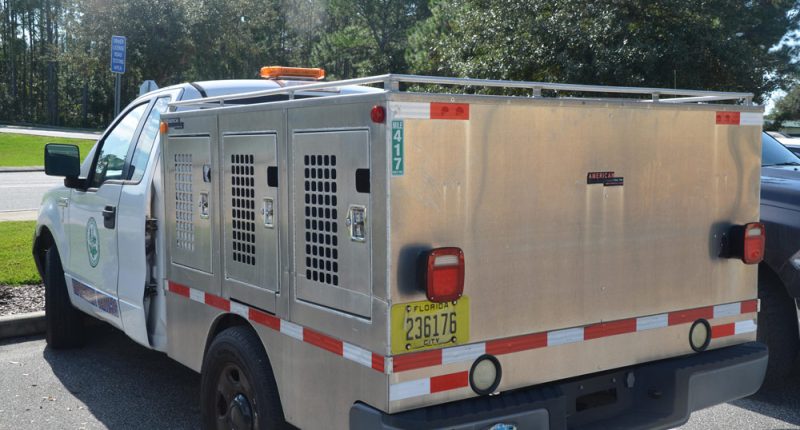
Flagler County government is estimating that if it were to run its own animal control operation, separate from the Flagler Humane Society, it would cost taxpayers $420,000 in the first year and an average of $333,000 a year, or close to the $304,000 budgeted for that this year. Currently, Flagler County government contracts with the non-profit Flagler Humane Society for the service. The cost was $237,000 in 2021, increasing 28 percent since.
County Commissioner Kim Carney says the numbers are not believable and are designed to set up for failure the proposal to break away from the Humane Society. Commissioner Leann Pennington, who is also interested in breaking away, is displeased with the slow pace of moving that way, despite the commission’s direction to its administration to have a plan fleshed out before the next one-year contract with the society runs out.
The issue, discussed at the end of a commission workshop on Wednesday (with Pennington chairing in place of Andy Dance, who had left by then: he has been recovering from surgery), underscored tensions on two fronts: between some commissioners and the county administration, and between county government and the Humane Society.
The county and Palm Coast have been disenchanted with the Humane Society over transparency, overcrowding and a drumbeat of public criticism of the non-profit. Palm Coast has its own animal control division but works in partnership with the Humane Society since it doesn’t have its own shelter. The county would have to do likewise.
The society’s is the only shelter in the county. It wants to expand but doesn’t have the money to do it. The county has had some discussions about having its own shelter or even contracting with the sheriff to run one. None of the discussions have gone past conceptual generalities. Shelters are very expensive to build and not inexpensive to run. That idea appears to have no realistic way forward. The only other option is for the county to have its own animal control operation.
County commissioners asked the administration to draft numbers outlining costs of animal services as a division of county government, doing so at the very time when commissioners have been pressuring County Administrator Heidi Petito to cut costs and shut down services where possible (as was the case Wednesday, when Commissioner Kim carney suggested the county’s elderly day care operation should be ended.)
The numbers Petito presented at Wednesday included capital costs recurring every five years and annual costs increasing at 5 percent a year, considerably less than the contract with the Humane Society has been increasing since 2020. Capital costs would include vehicles.
“At this point, because we don’t have all of the pieces, I don’t know that we can really move forward with it,” Petito said. She wanted to include Palm Coast’s animal control costs in the equation as the county studies the possibility of contracting with the city.
The report did not impress Commissioner Kim Carney, who said it was “designed for failure.”
“I just can’t believe it’s a half a million dollars to get started in the animal control business,” she said, questioning numbers such as the cost of two sets of uniforms, put at $3,000 (taht would be over five years), cellphones and radio fees for two employees put at $9,600, and so on. “It just makes me have more questions,” she said. “Two vehicles so that two people can drive around. Where are these people sitting all day until they get their phone call that they got to go pick up a dog? What are they doing all day?”
That prompted frustration from Petito as Carney’s questions often do. It was toward the end of what had been a tense workshop for much of the time. The commission had asked Petito to prepare the numbers, and now that she had–with the caveat that they were incomplete–Petito was being criticized for them.
Petito tone suggested that what she wanted to say was what do you want from me? What she actually said was: “Like I said, we’re not currently in the animal control business. It’s very hard to create a budget not knowing the scope and the magnitude of what they actually do, because I did not get a response to some of the questions and some of the concerns. As I stated, it’s a shot in the dark.”
County Attorney Al Hadeed, always attuned to the tensions in the room, attempted a rescue as he described to Carney the breadth of duties expected of animal control officers that go far beyond picking up dogs. Carney argued with him, too, over the cost of a $67,000 technician. “I’m not trying to argue for or against this. I’m just trying to explain the function,” he said.
Petito did get very general numbers from Palm Coast, based on 500 animals picked up in unincorporated Flagler County last year. She flashed those up on a screen after Carney’s criticism. The cost Palm Coast quoted would be closer to $400,000 a year, but the figures are not final. Carney wasn’t satisfied.
“500 dogs. I know we don’t run this service seven days a week,” Carney said. “It’s less than two dogs a day, or two to three dogs a day. This is not even fathomable. This isn’t believable. Doesn’t make sense.”
To Commissioner Leann Pennington, if the county were to have its own operation, it would make more sense to start with one officer, not two. Commissioner Greg Hansen cautioned that the county can’t have a three-dogs-a-day quota. “It’s not that easy,” he said. “They are on call. They don’t have a crystal ball. They’re ready to go if they get a call. So just be careful. Be careful.” Hansen thinks animal control should be a county service, like ambulance service, operating in the county and the cities.
That wasn’t Carney’s point. She said the idea is to combine operations with Palm Coast and share resources for better efficiencies. “The way they’re presenting this, it’s like they’re building a whole new department for Flagler County Animal Control,” Carney said. “I don’t think we need a whole new department. I’d like to see some sharing or integrating. This is not integrating.”
Palm Coast isn’t interested in bringing on new staff if the arrangement with the county were to be for just one year, Petito said. (Some commissioners had spoken of trying the experiment for a year.)
“It’s becoming more evident to me that it’s not going to be something that’s solved this year because of the delays,” Pennington said, even though the county has signed a one-year contract with the Humane Society. “But I think we need to bring it back to the board and make a decision one way or the other in August.”
That’s not likely. The city and county administrations are meeting in August to talk about the joint operations. The County Commission and the City Council are not meeting jointly on the issue before Aug. 27, Petito said.
It was Pennington’s turn to be frustrated. “There’s a lot of people here that worked hard for a year to get to this point, and I apologize that we’re not at that point,” Pennington said–meaning the point where the county could plan to sever its animal control operations from the Humane Society. “I thought that was pretty clear when we went into contracts last year, that we wanted to see other options. And clearly the year got the best of everybody. But we will not let up our foot on the pedal. We will keep going forward on this.”
Even though the county signed the contract, a clause in the contract allows the county to end it with four months’ notice, even if it renews for another year.











